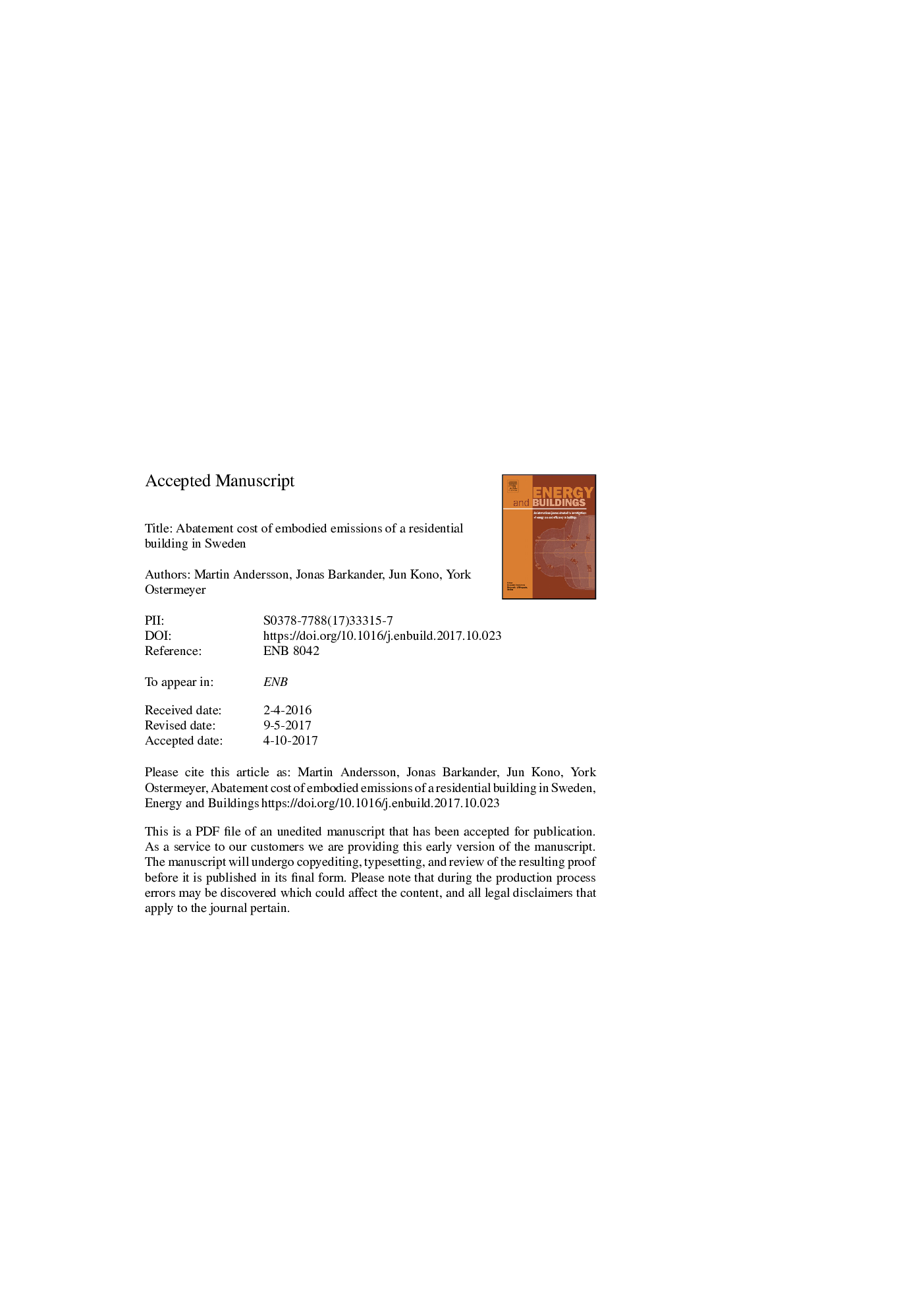| کد مقاله | کد نشریه | سال انتشار | مقاله انگلیسی | نسخه تمام متن |
|---|---|---|---|---|
| 6729445 | 1428932 | 2018 | 27 صفحه PDF | دانلود رایگان |
عنوان انگلیسی مقاله ISI
Abatement cost of embodied emissions of a residential building in Sweden
ترجمه فارسی عنوان
هزینه کم هزینه انتشار گازهای مجاز یک ساختمان مسکونی در سوئد
دانلود مقاله + سفارش ترجمه
دانلود مقاله ISI انگلیسی
رایگان برای ایرانیان
کلمات کلیدی
ترجمه چکیده
در سال 2010، حدود 19 درصد از کل گازهای گلخانه ای ساختمان های جهان به حساب می آیند. این انتشارات از ساخت و ساز و تأسیس ساختمان ها حاصل می شود. در سال های اخیر، بهره وری کربن منابع انرژی و بهره وری انرژی ساختمان های جدید در سوئد بهبود یافته است. بنابراین، گازهای تجدیدپذیر برای افزایش سهم چرخههای زندگی ساختمانهای جدید، به حساب میآیند. این مطالعه با هدف بررسی اثربخشی هزینه در کاهش انتشار گازهای گلخانه ای صورت می گیرد. این امر با ارزیابی انتشار گازهای احیا شده از ساختمان مورد و چندین اقدامات طراحی معمول همراه با پیامدهی به هزینه تولید انجام شد. مشخص شد که بسیاری از این اقدامات باعث کاهش هزینه کربن کربن می شود. با استفاده از مقادیر خنثی و تقریبا غیرمستقیم، انتشار گازهای موجود در آن مملو از 15٪ می شود. میزان تخریب تا 18 درصد در مقابله با کاهش انتشار دی اکسید کربن در سایر بخش ها موثر بود. کاهش تلفات تا 24 درصد ممکن بود با افزایش جزئی هزینه کل تولید (0.22 درصد)، حتی اگر برخی از اقدامات فردی در رابطه با کاهش انتشار دی اکسید کربن در سایر بخش ها گران بود، ممکن بود. برخی از اقدامات شامل افزایش سطح زمین است که می تواند به طور بالقوه منجر به سود اقتصادی که در آن منطقه بیرونی یک عامل محدود کننده است. الزامات آکوستیک فاکتور محدود کننده در کاهش انتشار گازهای گلخانه ای بود.
موضوعات مرتبط
مهندسی و علوم پایه
مهندسی انرژی
انرژی های تجدید پذیر، توسعه پایدار و محیط زیست
چکیده انگلیسی
In 2010, the world's buildings accounted for approximately 19% of all greenhouse gas emissions. These emissions stem from both the construction and operation of buildings. In recent years the carbon efficiency of energy sources and energy efficiency of new buildings has been improved in Sweden. Therefore, embodied emissions accounts for an increasing share of the life cycle emissions of new buildings. This study aims to asses the cost effectiveness in abatement of embodied emissions. This was done by assessing the embodied emissions of a case building and several conventional design measures along with the implication on production cost. It was found that many of the measures enabled cost effective carbon abatement. Embodied emissions could be reduced by 15% using cost neutral or nearly cost neutral measures. Abatements up to 18% were found cost effective in relation to abatement of carbon dioxide emissions in other sectors. Abatements up to 24% were possible with minor increases in total production cost (0.22%) even though some of the individual measures were found expensive in relation to abatement of carbon dioxide emissions in other sectors. Some measures entailed increased floor area that could potentially lead to economic gain where exterior area is a limiting factor. Acoustic requirements were found to be a limiting factor in abatement of embodied emissions.
ناشر
Database: Elsevier - ScienceDirect (ساینس دایرکت)
Journal: Energy and Buildings - Volume 158, 1 January 2018, Pages 595-604
Journal: Energy and Buildings - Volume 158, 1 January 2018, Pages 595-604
نویسندگان
Martin Andersson, Jonas Barkander, Jun Kono, York Ostermeyer,
